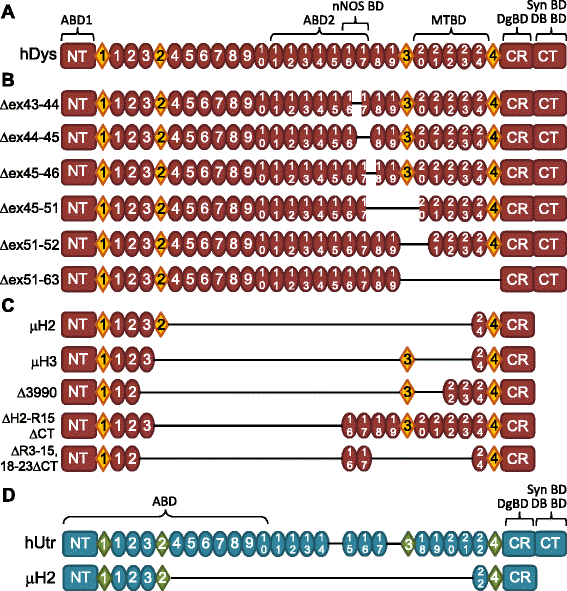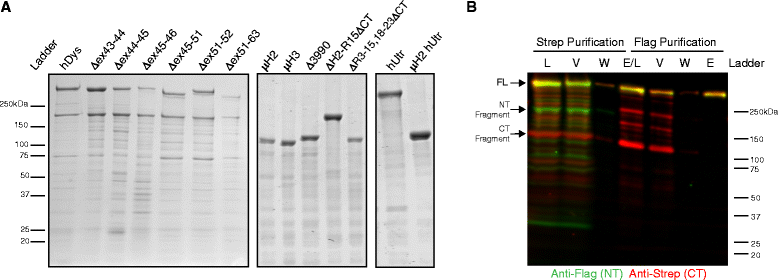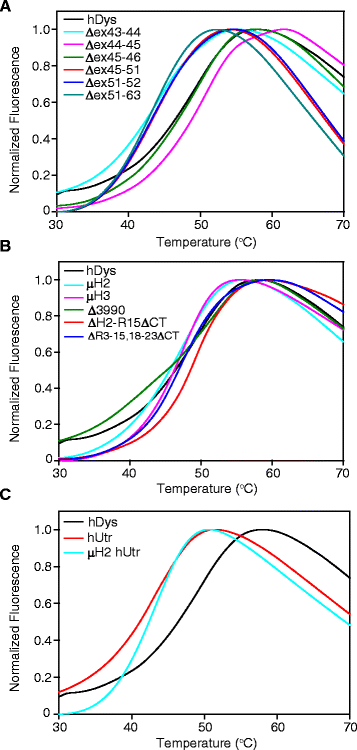In vitro stability of therapeutically relevant, internally truncated dystrophins
- PMID: 25954502
- PMCID: PMC4424174
- DOI: 10.1186/s13395-015-0040-z
In vitro stability of therapeutically relevant, internally truncated dystrophins
Abstract
Background: The X-linked recessive disease Duchenne muscular dystrophy (DMD) is caused by mutations in the gene encoding the protein dystrophin. Despite its large size, dystrophin is a highly stable protein, demonstrating cooperative unfolding during thermal denaturation as monitored by circular dichroism spectroscopy. In contrast, internal sequence deletions have been associated with a loss of the cooperative unfolding and cause in vitro protein aggregation. Several emerging therapy options for DMD utilize internally deleted micro-dystrophins and multi-exon-skipped dystrophins that produce partially functional proteins, but the stability of such internally truncated proteins has not been investigated.
Methods: In this study, we analyzed the in vitro stability of human dystrophin constructs skipped around exon 45 or exon 51, several dystrophin gene therapy constructs, as well as human full-length and micro-utrophin. Constructs were expressed in insect cells using the baculovirus system, purified by affinity chromatography, and analyzed by high-speed sedimentation, circular dichroism spectroscopy, and differential scanning fluorimetry.
Results: Our results reveal that not all gene therapy constructs display stabilities consistent with full-length human dystrophin. However, all dystrophins skipped in-frame around exon 45 or exon 51 show stability profiles congruent with intact human dystrophin. Similar to previous studies of mouse proteins, full-length human utrophin also displays stability similar to human dystrophin and does not appear to be affected by a large internal deletion.
Conclusions: Our results suggest that the in vitro stability of human dystrophin is less sensitive to smaller deletions at natural exon boundaries than larger, more complex deletions present in some gene therapy constructs.
Keywords: Becker muscular dystrophy; Duchenne muscular dystrophy; Dystrophin; Exon skipping; Gene therapy; Utrophin.
Figures





Similar articles
-
Internal deletion compromises the stability of dystrophin.Hum Mol Genet. 2011 Aug 1;20(15):2955-63. doi: 10.1093/hmg/ddr199. Epub 2011 May 10. Hum Mol Genet. 2011. PMID: 21558423 Free PMC article.
-
Antisense-induced exon skipping for duplications in Duchenne muscular dystrophy.BMC Med Genet. 2007 Jul 5;8:43. doi: 10.1186/1471-2350-8-43. BMC Med Genet. 2007. PMID: 17612397 Free PMC article.
-
Exon-skipped dystrophins for treatment of Duchenne muscular dystrophy: mass spectrometry mapping of most exons and cooperative domain designs based on single molecule mechanics.Cytoskeleton (Hoboken). 2010 Dec;67(12):796-807. doi: 10.1002/cm.20489. Epub 2010 Nov 10. Cytoskeleton (Hoboken). 2010. PMID: 20886611 Free PMC article.
-
Theoretic applicability of antisense-mediated exon skipping for Duchenne muscular dystrophy mutations.Hum Mutat. 2009 Mar;30(3):293-9. doi: 10.1002/humu.20918. Hum Mutat. 2009. PMID: 19156838 Review.
-
Exon skipping therapy for Duchenne muscular dystrophy.Adv Drug Deliv Rev. 2015 Jun 29;87:104-7. doi: 10.1016/j.addr.2015.05.008. Epub 2015 May 14. Adv Drug Deliv Rev. 2015. PMID: 25980936 Review.
Cited by
-
Interrogation of Dystrophin and Dystroglycan Complex Protein Turnover After Exon Skipping Therapy.J Neuromuscul Dis. 2021;8(s2):S383-S402. doi: 10.3233/JND-210696. J Neuromuscul Dis. 2021. PMID: 34569969 Free PMC article.
-
Dose-Escalation Study of Systemically Delivered rAAVrh74.MHCK7.micro-dystrophin in the mdx Mouse Model of Duchenne Muscular Dystrophy.Hum Gene Ther. 2021 Apr;32(7-8):375-389. doi: 10.1089/hum.2019.255. Epub 2021 Feb 18. Hum Gene Ther. 2021. PMID: 33397205 Free PMC article. Clinical Trial.
-
Development of Novel Micro-dystrophins with Enhanced Functionality.Mol Ther. 2019 Mar 6;27(3):623-635. doi: 10.1016/j.ymthe.2019.01.002. Epub 2019 Feb 1. Mol Ther. 2019. PMID: 30718090 Free PMC article.
-
CRISPR-Editing Therapy for Duchenne Muscular Dystrophy.Hum Gene Ther. 2023 May;34(9-10):379-387. doi: 10.1089/hum.2023.053. Hum Gene Ther. 2023. PMID: 37060194 Free PMC article. Review.
-
Mouse models of two missense mutations in actin-binding domain 1 of dystrophin associated with Duchenne or Becker muscular dystrophy.Hum Mol Genet. 2018 Feb 1;27(3):451-462. doi: 10.1093/hmg/ddx414. Hum Mol Genet. 2018. PMID: 29194514 Free PMC article.
References
-
- Ervasti JM. Dystrophin, its interactions with other proteins, and implications for muscular dystrophy. Biochim Biophys Acta. 2007;1772:108–17 - PubMed
Grants and funding
LinkOut - more resources
Full Text Sources
Other Literature Sources

